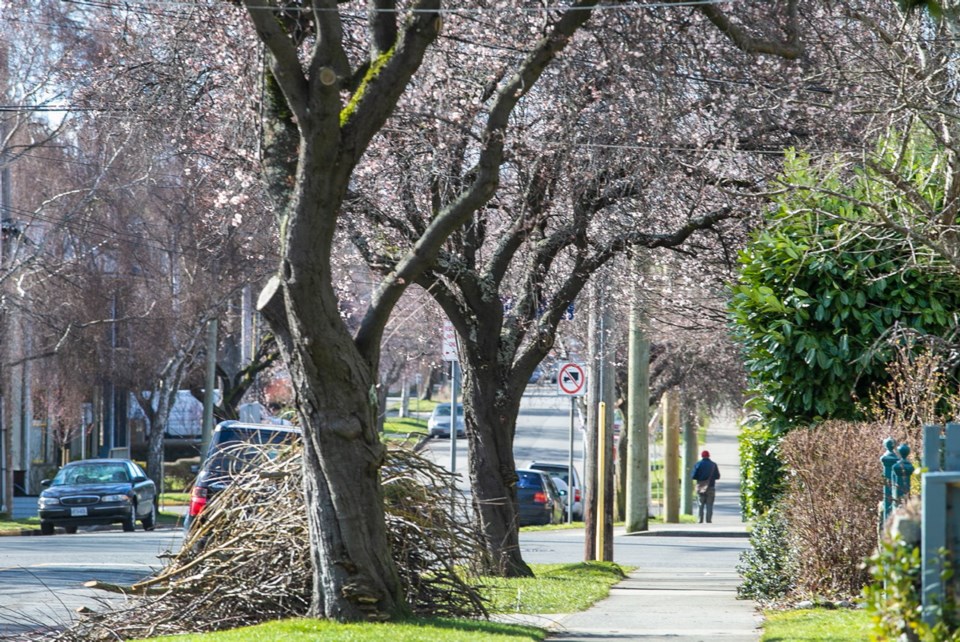February’s far-too-long cold snap might have nipped the region’s more adventurous flowering trees in the bud, but remarks by Victoria Coun. Geoff Young that additional funding for the city’s tree-management program could lead to the eventual loss of cherry-blossom trees turned residents’ attention to the region’s iconic spring blossoms even amidst the frost.
The city has since clarified that the cherished cherry trees are neither immediately on the cutting block nor considered potential cut blocks.
Although flowering cherries have been planted here for more than century, the trees’ reign over Victoria’s collective streetside consciousness began almost nine decades ago, when Victoria parks superintendent Herb Warren began a campaign to replace the overgrown, overly tall and large roadside elms, oaks, maples and horse chestnuts whose roots were heaving sidewalks and blocking sewage drains. Aiming for tree varieties of “medium size, fairly upright and ornamental because of flowers, fruit and foliage,” Warren envisioned canopies of springtime blossoms to attract visitors and new residents.
Japanese flowering cherry trees fit the bill.
Throughout the 1930s, Warren unfolded his beautification campaign street by street. Staff would plant one boulevard with one variety and the next street with another so that blooms would sweep each street at different times each spring.
But the Depression-era parks committee could allocate only so much toward tree stock and labour.
As described in Ann-Lee and Gordon Switzer’s 2012 book, Gateway to Promise: Canada’s First Japanese Community, the campaign’s grace note came from the city’s Japanese community.
It entered a float in two August 1937 parades held to celebrate Victoria’s 75th anniversary since incorporation. The float was decorated with a handmade, blossoming cherry tree and wisteria, Japanese lanterns and young girls in kimonos.
Admired and praised, the entry won cash prizes totalling $300, which the association then decided to put toward buying flowering cherry trees for Beacon Hill Park. Warren guided their purchases by suggesting specific varieties, nurseries, sizes and numbers. He also asked permission to plant some of the trees on the city’s boulevards.
In total, Victoria’s Japanese Community Association donated 1,013 Japanese flowering cherry trees.
Elsewhere, other, similar donations by people with ties to Japan led to cherry-tree street- and parkscapes along B.C.’s coast.
In the early ’30s, the mayors of Kobe and Yokohama presented Vancouver’s park board with 500 Japanese cherry trees for planting at the Japanese cenotaph in Stanley Park to honour Japanese Canadians who served in the First World War. In 1958, Japanese consul Muneo Tanabe followed up with another 300 ornamental cherry trees. His trees were planted along Cambie Street and in Queen Elizabeth and Stanley parks.
Farther north, in Prince Rupert, Shotaru Shimizu, former owner of the city’s 30-room New Dominion hotel, arranged for 500 Japanese cherry blossom trees to be imported and planted in the city.
His generosity is all the more remarkable for occurring in 1959, years after the forced 1942 wartime relocation of him, his family and other Canadian citizens of Japanese ancestry from coastal areas to the B.C. Interior, confiscation of property and goods, and postwar ban on returning to the coast to live. His trees were planted throughout the city, including next to the then-new federal building. Private citizens also received trees for their gardens.
Last March, when the federal government began removing Shimizu’s aged cherry trees next to the Department of Fisheries and Oceans building, Prince Rupert residents protested vociferously. The government has since apologized, replaced the missing trees and regrafted the damaged trees. It installed a plaque commemorating Shimizu’s contributions to the community and his donation.
In many of B.C.’s coastal cities, what cherry blossoms really represent is forgotten. They symbolize communities and citizens that once thrived here but were uprooted due to war and prejudice. They are overlooked reminders of ties between communities across time and ocean. They commemorate opportunities that we and our parents enjoyed in making and shaping our lives here and they commemorate the precariousness of life. They represent hope and fleeting beauty.
And, among all that, the sakura — the Japanese name for flowering cherry trees — signals the start of spring amid the lingering possibility of frost.



